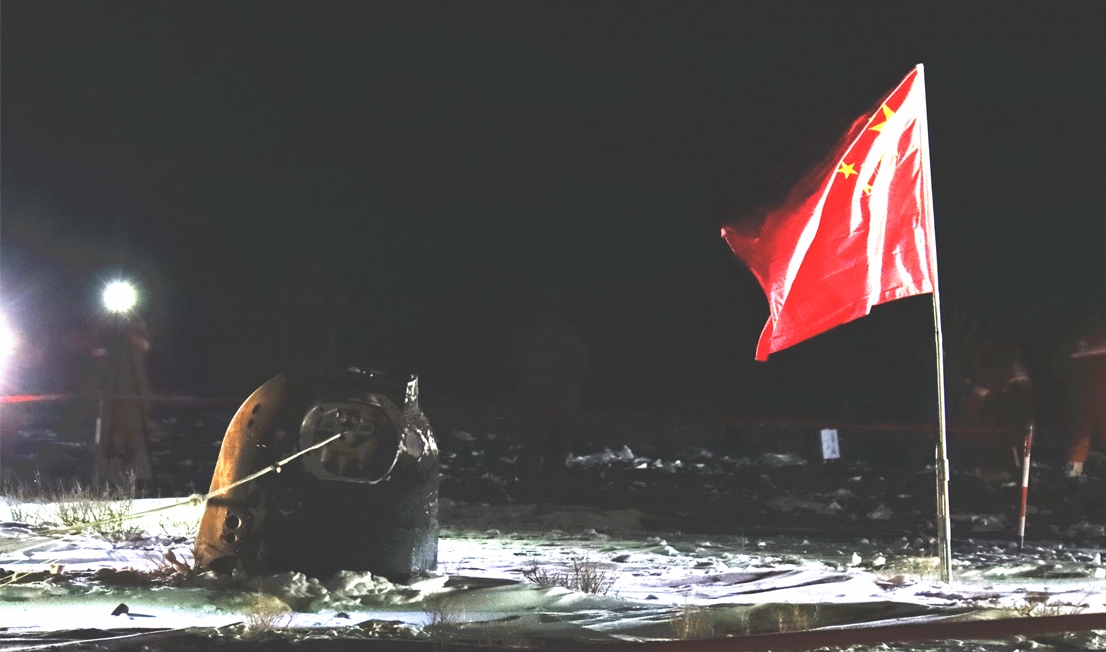China's Chang'e-5 moon samples contain 'perplexing combination' of minerals
Changesite-(Y) is the sixth new lunar mineral to be discovered.

Old and new minerals found in lunar samples brought home by China's Chang'e-5 mission are helping scientists better understand the moon's history.
In 2020, Chang'e-5 returned 3.8 pounds (1.73 kilograms) of rocks and dust from Oceanus Procellarum (the Ocean of Storms), the largest dark region on the moon, which can be seen on its western edge. An analysis of these samples has revealed a new mineral, which has been named changesite-(Y), scientists reported in a paper published Wednesday (Feb. 6).
Changesite-(Y) was discovered by researchers at the Beijing Research Institute of Uranium Geology (BRIUG), and is the sixth new lunar mineral to be found.
Related: China makes Chang'e 5 moon samples open to international researchers
The moon is pocked with craters from asteroid strikes, which are left as-is thanks to the lack of atmosphere and geologic activity on the moon. The intense pressures and temperatures from asteroid impacts change the composition of the top layer of lunar rock and dust, called regolith, which scientists study to piece together the moon's turbulent history.
Changesite-(Y) must have formed in the aftermath of one such asteroid impact, one that likely left a crater anywhere from 1.9 miles to 20 miles (3 to 32 kilometers) wide depending on the impact angle, according to estimates from computer models. A previous analysis pinned the age of the returned moon rocks by Chang'e-5 at 1.97 billion years old.
The returned Chang'e-5 samples also contain a mix of previously known silica minerals, most notably seifertite and stishovite. Scientists think those two minerals were likely deposited by the collision that formed the Aristarchus crater, the youngest of four impact craters from which ejecta rained down onto the Oceanus Procellarum region toured by Chang'e-5.
Get the Space.com Newsletter
Breaking space news, the latest updates on rocket launches, skywatching events and more!
Seifertite is known to change into stishovite during the high-pressure aftershocks of an asteroid impact, but there's much left to learn about these minerals on the moon.
"Although the lunar surface is covered by tens of thousands of impact craters, high-pressure minerals are uncommon in lunar samples," study co-author Wei Du of the Chinese Academy of Sciences said in a statement. "One of the possible explanations for this is that most high-pressure minerals are unstable at high temperatures."
Theoretically, seifertite and stishovite are able to coexist only at much higher pressures than the sample seems to have witnessed, so their presence in Chang'e-5's returned sample is a "perplexing combination," scientists say.
This May, China is expected to launch its next moon mission, Chang'e-6, which will attempt to gather samples from the South Pole-Aitken (SPA) basin on the far side of the moon.
The new research was described in a paper published Wednesday (Feb. 6) in the journal Matter and Radiation at Extremes.
Join our Space Forums to keep talking space on the latest missions, night sky and more! And if you have a news tip, correction or comment, let us know at: community@space.com.

Sharmila Kuthunur is a Seattle-based science journalist focusing on astronomy and space exploration. Her work has also appeared in Scientific American, Astronomy and Live Science, among other publications. She has earned a master's degree in journalism from Northeastern University in Boston. Follow her on BlueSky @skuthunur.bsky.social









